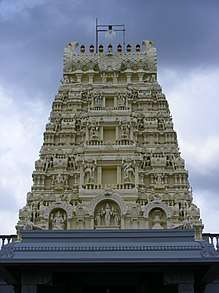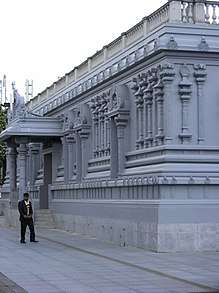British Sri Lankan Tamil
| பிரித்தானியத் இலங்கை தமிழர் | |
|---|---|
 | |
| Total population | |
| 150000~200000 | |
| Languages | |
| English, Tamil | |
| Religion | |
| Hinduism, Christianity | |
| Related ethnic groups | |
| British Tamils, British Sri Lankans, British Indians |
British Sri Lankan Tamil (பிரித்தானியத் இலங்கை தமிழர்) refers to a demographic construct concerning British citizens and residents who descend from Tamils on the island of Sri Lanka, and it's notable that the definition frequently excludes those on the island that have been segregated into other groups, namely Moors and Hill Tamils.[1]
The United Kingdom is home to the largest population of Sri Lankan Tamils in Europe, albeit only by a narrow margin, and it is among the most populous communities of Sri Lankan Tamils worldwide. An estimate by the Financial Times placed the number of Sri Lankan Tamils in the UK at just under 200,000.[2]
Sri Lankan Tamils can be part of several other larger demographic groups and therefore many Tamils will not identify as "Sri Lankan Tamil". These include: British Tamil, British Sri Lankan, British Indian and British Asian. There are fluid connections between British Sri Lankans and British Indians, particularly along ethnolingustic and ethnoreligious lines.
History
Immigration of significant numbers of Tamils to the United Kingdom (UK) started with economic immigrants in the 1940s. These were joined by students moving to the UK for education in the 1970s.[3]
Sri Somasundaram Sabapathipillai was a famous early immigrant to the UK. A lawyer born in 1910, he founded the Hindu Association of Great Britain in 1966, which in turn established the first Hindu temple in Europe in 1981 - servicing the needs of the Tamil community.[4]
Baby Boomers and Generation X
The upheaval caused by the Civil War caused many people to uproot from the island and move to more peaceful countries, a consequence being that a significant number of Tamils from the island immigrated to the United Kingdom; the majority of these immigrants settled using student visas and family reunion visas.[5]
A few immigrants established a handful of community networks, such as Tamil Pages, in order to service the needs of Tamils, with a large number of activist political organizations being created in order to advance political viewpoints concerning the Civil War - mainly of Tamils on the island.[6]
The immigrants managed to settle in the UK using student visas and educated themselves into higher ranking jobs - they are viewed as an example of successful integration - and they have a more middle class profile.[7]
A large business profile has been founded in the UK, with the Tamil Chamber of Commerce stating that Tamil businesses generate around $1 billion for the UK economy; two global telecommunication companies have been founded by immigrants - including Lebara and Lyca.[8]
There have been many activist political movements held by some immigrants in relation to the Civil War and the most notable demonstration was held in April 2009 in London where around 100,000 people attended.[9]
Millennial Era
A significant population of second generation exist in the UK. They are typically brought up away from other people of their own ethnicity, and without siblings due to sub-replacement fertility rates in the community, with their parents working their way into higher-ranking professional jobs by utilising educational facilities.[5]
The former youngest person to pass their A-Levels in the UK is "Ganesh Sittampalam", and this is symbolic of the progressive rates of social mobility and educational attainment professed by the second generation.[7]
The majority of these people have entered higher education and found themselves in jobs sectors such as the financial and medical industry - most notably mirroring people descended from the Republic of India.[10]
Demographics
The UK has always had a strong, albeit small, population of Sri Lankan Tamils deriving from colonial era immigration between Sri Lanka and the UK, but a surge in emigration from Sri Lanka took place after 1983, as the civil war caused living conditions deteriorate and placed many inhabitants in danger. It is now estimated that the current population of British Sri Lankan Tamils numbers around 100,000 to 200,000.[11]
They are spread out throughout the country and did not segregate in the manner that some other Asian communities have, an abnormal circumstance being found in the London borough of Kingston, where around 6% (~10,000) of the population is of Sri Lankan and/or Tamil origin.[12]
The largest population of British Sri Lankan Tamils can be found in London, chiefly in Harrow (West London), where a large Indian population has existed for decades, and Tooting (South London).[13] The community generally has far lower birth rates in comparison to other South Asian ethnic groups, with one child for two parents being the norm.[14]
Socioeconomics
Unlike immigrants to countries in Continental Europe, the majority of Sri Lankan Tamils that went to live in the UK achieved entry through non-refugee methods such as educational visas and family reunion visas, owing to the highly educated in Sri Lanka being literate in English as well as Tamil. This resulted in the first generation diaspora falling into highly professional jobs such as medicine and law after studying at British educational facilities.[5][10]
The Tamil Chamber of Commerce (TCC), for example, estimated in March 2011 that there are five thousand Tamil-owned businesses in UK with a turnover of 1 billion GBP.[8]
Percentage of children gaining 5 'A* to C' grades
| Ethnicity | Difference from average (%) in 2011 | Difference from average (%) in 2003 |
|---|---|---|
| Chinese | +38% | +11% |
| Tamil | +32.5% | +8% |
| Indian | +29.9% | +7% |
| Average | 0 | 0 |
| White British | -2.3% | +1% |
| Pakistani | -8.6% | -11.3% |
| Somali | -23.7% | -22.3% |
Politics
The Sri Lankan Civil War has played a crucial role in the political actions of the Sri Lankan Tamil community. A number of activist organisations have been established by first generation immigrants in order to represent the voice of the Sri Lankan Tamils on the island, and several major protests have been held in order to forward various viewpoints about the Civil War, most notable of which was a mass demonstration in April 2009 which drew nearly 100,000 protestors.[9]
The second generation have however generally been more emotionally detached from the politics of the civil war, giving more priority to the issues in the United Kingdom and European Union, and preferring to refrain from involving themselves into the more extreme activism surrounding the Civil War.[18] A number of political persons, such as Chamali Fernando, have advocated harder stances against asylum seekers and terrorism.[19]
There have been several high-profile donors[20][21] to the Conservative Party from the Sri Lankan Tamil community.
Culture
The second generation generally do not speak Tamil fluently enough to relate to South Asian culture and media, beyond news and politics, and therefore have traditionally avoided popular Indian culture like Kollywood (music and films) and literature. A number of scholars have suggest that this points to a relative success of integration by the community.[22]
Social values

The community, while in theory should be more liberal than other communities in Western and Southern Asia, has some paternal aspects that clash with liberal western youth values. A number of second generation have commented on how their first generation parents tend to look down on many elements of western youth culture (binge drinking, illegal drugs, promiscuity, etc.), and issues such as mental illness, homophobia, colourism, and misogyny have often received minor vocal opposition from first generation Sri Lankans.
However, there are elements of Sri Lankan Tamil culture that are markedly more liberal than other South Asian communities. There is widespread tolerance towards the concept of love before marriage and the majority of Tamils are not subject to forced marriage (arranged marriages are always optional), and women are often encouraged to participate in the education and labour market prior to marriage.[23]
Religion
Sri Lankan Tamils are predominantly Hindu, albeit a large Christian population exists; much of Sri Lankan Tamil traditional culture is rooted in Hinduism and Christian Tamils find it increasingly difficult to maintain a cultural identity that is separate and distinct from Hinduism. 'Raj' argued that there has been a 'Hindu resurgence' in the UK, whereby the young second generation living in the Hindu diaspora are reconstructing and realigning themselves with the faith of their parents.[24]
Chakravoty discusses how British Sri Lankan Tamil youth often carried forward elements of religion from their parents into their own daily lives, such as the widespread practice of religious rituals such as the Bharatnatyam.[25]
London is today home to at least 23 Saivite temples founded by Sri Lankans, and the Hindu Association of Great Britain was founded by them in 1966 to foster relations among Hindus.The latter organisation established Europe's first Hindu temple, the Wimbledon Ghanapathy Temple, in the 1980s.[4]
Notable people
- Ratheesan Yoganathan - founder of global telecommunications brand Lebara Mobile.
- Dharshini David - a former economist at HSBC, she is now a prominent journalist for Sky News.
- Tim Kash - A former British resident that was famous for being an MTV VJ. He currently resides in New York City and works for MTV and E!.
- M.I.A. - rapper
- Ganesh Sittampalam - record holder for being the youngest person ever to pass an A-Level examination.
- Dimitri Mascarenhas - a British-Australian cricketer who has played in international matches for England and the IPL.
- Inno Genga - musician
- Romesh Ranganathan - comedian
- Amara Karan - actress
See also
References
- 1 2 Krishna, Sankaran (1999). Postcolonial Insecurities"India, Sri Lanka, and the Question of Nationhood. U of Minnesota Press. ISBN 9781452903873.
- ↑ "Subscribe to read". Financial Times. Retrieved 2017-07-20.
- ↑ Dissanayake, Samanthi (8 December 2008). "UK Tamils polarised but powerful". BBC News. Retrieved 27 December 2009.
- 1 2 Academy, Himalayan. "Tradition: London: A Sri Lankan Citadel of Saivism - Magazine Web Edition > October/November/December 2015 - Publications - Hinduism Today Magazine". www.hinduismtoday.com. Retrieved 2017-07-21.
- 1 2 3 "Children of Refugees" (PDF).
- ↑ "Understanding the Politics Of the Sri Lankan Tamil Diaspora" (PDF). GM Research Paper N14 – via Graduate Institute.
- 1 2 "Unique Socioeconmic Positioning of Sri Lankan Tamils" (PDF).
- 1 2 "Tamil Chamber of Commerce".
- 1 2 "Political Identity of the British Tamil Diaspora" (PDF).
- 1 2 "FT on Sri Lankan Tamils".
- ↑ "IOM London" (PDF). Archived from the original (PDF) on 2011-07-26.
- ↑ "Borough Profile 2013" (PDF).
- ↑ "The Economist".
- ↑ "The Sri Lankan Population of Great Britain" (PDF).
- ↑ Institute for Public Policy Research (2007a).
- ↑ Freedom of Information Requests to Local Authorities in 2012.
- ↑ "A Gift from the Heart for Hartley". The Sunday Times.
- ↑ "The Sri Lankan Tamils" (PDF).
- ↑ "Interview with Chamali Fernando".
- ↑ "Tamil diaspora links to David Cameron exposed". Retrieved 2017-07-21.
- ↑ "Tamil businessman gave the Tories more than £1m in donations". Mail Online. Retrieved 2017-07-21.
- ↑ "Refugees and the Second Generation".
- ↑ "Whiterose Academic Report on Sri Lankan Tamils" (PDF).
- ↑ "Sandhya Marla".
- ↑ Chakravorty, Pallabi; Gupta, Nilanjana (2012-08-21). Dance Matters: Performing India on Local and Global Stages. Routledge. ISBN 9781136516139.